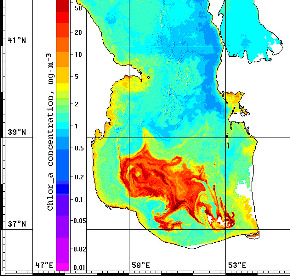Caspian Sea >> Anomalous Algal Bloom
English | Russian
Anomalous Algal Bloom (AAB) occurred in the Southern Caspian
in 2005 with affected area of 20,000 km2. The unprecedented bloom
developed in the beginning of the second decade of the August and existed until
the end of September. Development process was very fast – the phenomenon was
first registered at the satellite image on August, 12 and reached its
maximum on September, 1. Analysis of the satellite images for the same
season in previous five years did not confirm that phenomenon of such scale
have ever occurred before.



AAB on MODIS satellite images: a) August 17, 2005 b) September 1, 2005
In the middle of September AAB reached the
Iranian coastal area amazing local citizens and hampering fishing in the
area. Iranian Fisheries Research Organization (IFRO) based on morphological
characteristics, identified alga species responsible for the AAB as cyanobacteria Nodularia.
The thickness of the floating alga layer was estimated in tens centimeters, its
biomass was huge. The risk of serious pollution of coast and coastal waters
with alga decay products was very high, but fortunately changes in the weather
prevented propagation of the AAB further to the shore and later on led to its
destruction.

AAB near Iranian coast (Photo courtesy of Dr. Roohi, IFRO)
Following the recommendation of the Steering Committee CEP undertook
investigation of the temporal and spatial characteristics of cyanobacterial bloom occured in September-October 2005
using Remote Sensing Technique with aim of developing capacity for observation and prediction of AAB
in the Southern Caspian. The work was done by Consultant Dmitry Soloviev from the Marine Hydrophysical Institute, Ukraine
(MHI has long time experience in processing of satellite data on marine environment).
All cloud free MODIS Aqua and AVHRR data were processed for period August – September 2005
and values of Chl-a, SST (Sea Surface Temperature), and WLR (Water Leaving Radiation) were calculated.
Registered in the bloom area values of Chl-a concentration exceeded 50 mg/m3. Unfortunately NASA algorithms
for MODIS are not applicable for bloom area interpreting the situation as clouds. Analysis of the satellite images
during the same/close period in previous five years did not detect strong anomalous bloom in the area of interest.


Chlorophyll-a and WLR412 concentration maps for September 01, 2005
The study was successful, showing that AAB can be well detected using
remote sensing technique at the very initial stage. It provided an idea regarding a reason (trigger)
for the AAB event in Southern Caspian in 2005: this is warming-up of the sea surface layer above 30C°
in conditions of low wind. The full study report can be downloaded here.
Taking into account that the first half of July 2006 is even warmer than
the same period of 2005, occurring of AAB in Southern Caspian in 2006 is likely expected,
therefore the operational monitoring of AAB in the Southern Caspian using remote sensing technique
in period August – September 2006 was undertaken in order to predict and identify AAB event on early stage
and provide relevant information to Caspian scientists and stakeholders on near real time basis through
the CEP Web Site.
Totally 20 passes of the MODIS and 76 passes of the AVHRR were processed for the August – September 2006 (view report),
however AAB was not observed in the investigated area, perhaps due to different conditions in comparison with 2005.
Field investigations were undertaken by IFRO, I.R.Iran in September-October 2006 (view report). Small scale algal bloom was
observed in coastal waters of Iran in October 2006 with another responsible specie - Heterocapsa.
The result of the AAB studies were discussed at the workshop held in CEP-PCU on 19th of February 2007,
which recommended continuing researches since the AAB could be a new phenomena indicating changes in the Caspian environment.
©2009 CaspEcoProject Management and Coordination Unit
7-th floor, Kazhydromet Building, Orynbor st., Astana, 010000, Republic of Kazakhstan,
Tel. No.: (+7 7172) 798317; 798318; 798320, 798307, E-Mail: MSGP.MEG@undp.org
